Growing Gingers for the Asian Kitchen
Gingers are grown and widely consumed all over the world. The Ginger family Zingiberaceae boasts a great variety of edible plants such as the Common Ginger, Lengkuas, Fingerroot, Turmeric and Pink Torch Ginger! Many of these are distributed throughout the tropical and subtropical regions and found in Southeast Asia. They are used as spices or flavouring agents due to their aromatic fragrance and spicy taste. Some that have attractive features such as colourful flowers or leaves are cultivated as ornamental plants, while others are used in traditional medicines.
If you are a seasoned gardener or new to gardening, gingers are great plants to grow as most are easy to grow, have ornamental appeal and can provide a harvest for the kitchen – rhizomes, leaves and even flowers of some species are edible. Read on to learn about the characteristics and ethnobotanical uses of three ginger species, which are suitable for growing in pots, home gardens and small spaces.
Comparison of the rhizomes of Common Ginger, Turmeric and Cekur
Common Ginger (Zingiber officinale)
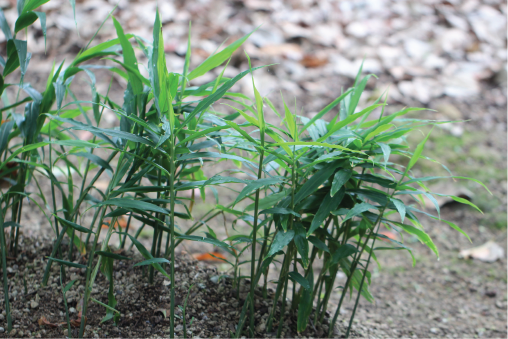
Common Ginger plants growing in clumps
Photo credit: Shi Biying
The Common Ginger or Halia (Zingiber officinale) is widely consumed as a spice in Asian cuisine and used for medicinal purposes such as to treat the cold, morning sickness, and indigestion. Research has shown the plant to have anti-inflammatory, anti-fungal, anti-cancer, and anti-arthritis properties.
Ginger plants have underground stems called rhizomes that have pale yellow flesh and strong spicy scent – these are the main part of the plant that is eaten. Able to grow upright to about 1.8 m tall, the Common Ginger grows best in well-drained soil with six to eight hours of filtered sunlight and regular watering. These rhizomes are easily found in many local markets and grocery stores.
To grow the Common Ginger, choose a healthy and plump-looking rhizome. If large, the rhizome can be divided into pieces about 3 to 4 cm wide; each piece should have at least one bud called the “eye”. Place a rhizome piece into the soil about 5 cm deep with the “eye” facing upwards. Rhizomes of this herbaceous plant grow horizontally underground at a shallow depth; therefore, wider pots of at least 20 cm wide and 20 cm deep are recommended for each rhizome piece so that it can grow into a good-sized ginger. Adding mature compost to the soil can help to retain moisture and provide nutrients to your growing ginger and cover some of the rhizomes that may appear above the ground as the plant grows.
Shoots usually sprout in about three weeks from the day of planting and young gingers can be harvested after four months, while mature gingers take at least eight months. To harvest them, gently uncover the rhizomes and dig the plant up with a small spade. You may select your preferred rhizomes and replant the remaining rhizomes for a continuous supply of Common Ginger for your kitchen recipes!
Turmeric (Curcuma longa)
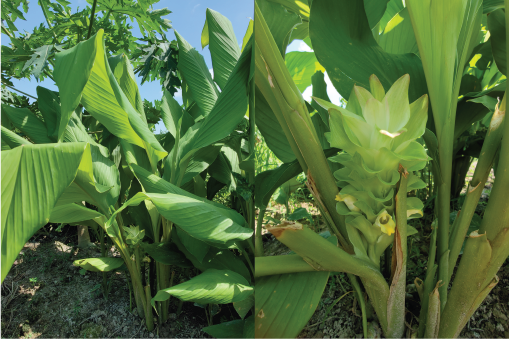
Plant and flower bracts of the Turmeric
Photo credit: Pauline Tay
An aromatic herbaceous perennial, the Turmeric (Curcuma longa) has a long history of being used as a spice in Asian cooking and as a source of dye for fabrics and food. Although the Turmeric plant is well known for its orange, fleshy rhizomes that are used in dishes, the leaves and flower bracts are also edible. They are used as flavour enhancers for meats and fish in grilled dishes, eaten raw as ulam or cooked as a vegetable in dishes.
Turmeric is often featured in Ayurvedic and traditional Chinese medicine; research has shown that Curcumin, a major component found in the Turmeric rhizome, has strong anti-inflammatory, antiseptic and antioxidant properties, making it suitable for treating wounds, infections, and stomach problems.
Fast-growing and able to reach up to 1 m tall, the Turmeric plant has large, broad, and thin papery leaves. It grows best in soil that is rich in organic matter such as garden soil or potting mix, with six to eight hours of filtered sunlight and ample watering once or twice a day. This herbaceous plant can tolerate growing under full sun once fully established. It is important to note that the soil should be kept well-drained as the rhizomes do not like “wet feet” or having the soil become water-logged. This can result in rotting of the rhizomes.
Turmeric rhizomes are commonly sold in many local wet markets and grocery stores. Just like the Common Ginger, when selecting a rhizome to grow the Turmeric plant, choose plump mature rhizomes that are not mouldy or shrivelled. If the clump is large, break it into smaller oval rhizomes, which can be from 3 to 6 cm in length. Plant these directly into the soil about 5 cm deep. Wider pots of at least 20 cm wide and 20 cm deep are recommended for each rhizome piece to allow sufficient horizontal space for the healthy growth of rhizomes. New shoots usually appear about three weeks to form from planting date and mature rhizomes can be harvested in 10 to 12 months. To harvest the leaves, cut the leaf sheath or flower stalk near its base with a pair of clean scissors.
Cekur (Kaempferia galanga)
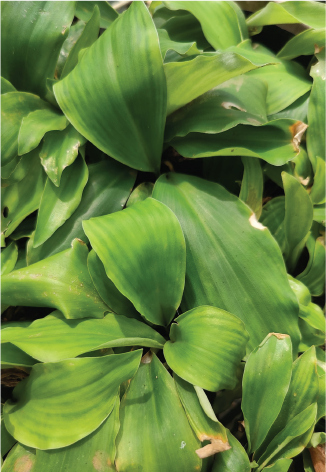
Leaves of Cekur growing flat to the ground
Photo credit: Pauline Tay
The Cekur (Kaempferia galanga) or Kencur bears edible leaves and aromatic rhizomes that are widely used in a variety of Asian medicines and culinary dishes. The young leaves are usually eaten raw as salad or in nasi kerabu (a Malay herb rice dish) while the rhizomes are usually used in cooking as a spice. Studies have also shown that leaves and rhizomes of Cekur have antioxidant, anti-inflammatory and wound-healing properties, making them important ingredients in the traditional medicine. For example, Cekur can be found in Indian Ayurvedic formulations for rheumatism, Thai traditional medicine for menstrual disorders in Thailand traditional medicine, and in a Malaysian herbal preparation called Jamu.
The Cekur grows horizontally in a rosette pattern, close to the ground. Its broad egg-shaped leaves are smooth on the upper surface but hairy and velvety to the touch on its undersides. Its delicate white flowers tinged with purple are shaped like butterflies and last for a day. Rhizomes and young seedlings are sold in our local wet markets like Tekka Centre or Geylang Serai Market.
To grow Cekur, the whole rhizome clump can be planted directly into fertile loamy soil such as garden soil or potting mix at depths of 2 to 3 cm. Choose wide pots of at least 20 cm wide and 20 cm depth for two or three rhizome clumps as the rhizomes grow horizontally underground and wider pots provide more space for optimum growth. Cekur is shade loving and grows well with at least 6 hours of filtered sunlight daily. Water the plant only when the soil feels dry to the touch as overwatering can cause the rhizomes to rot. Shoots usually take about four weeks to form from the point of planting and the leaves can be harvested in four months while rhizomes can be harvested in about 10 months. To harvest, gently uncover the rhizomes and dig them up with a small spade.
Growing these gingers is easy, these aromatic flowering plants are also beneficial for health and can be used in so many ways. Add these gingers into your home gardens and enjoy a bountiful harvest!
Take Part in Gardeners’ Day Out
Participate from the comfort of your home with online activities such as talks and demonstrations, video tutorials of activities and promotions offered. Free guided tours will also be offered on site. Enjoy Gardeners’ Day Out online at www.nparks.gov.sg/GDO.
You can also enjoy our Gardening With Edibles Masterclass Series from your home. They are conducted by NParks horticulturists, focusing on unique and challenging edibles across different plant families.
Gardening with Edibles
The City in Nature vision seeks to bring greenery closer to all residents. The community plays a key role in the ownership and stewardship for nature which will benefit our health and well-being. NParks is partnering residents to make Singapore our City in Nature and spark a love for community gardening through the Gardening with Edibles initiative under the Edibles Horticulture Masterplan.
Since the initiative’s launch in June 2020, some 860,000 free seed packets have been distributed to interested members of the public. The programme was established by founding partners DBS Bank and Tote Board through the Garden City Fund, a registered charity established by NParks. The most recent round of seed distribution, which took place in December 2021, was made possible by the programme’s partner Singapore Post Limited, also through the Garden City Fund. Relevant resources are available online, to guide gardeners along the way.
The Gardening with Edibles initiative is aligned with Singapore’s national strategy to strengthen our food resilience. The “30 by 30” goal, led by the Singapore Food Agency, aims to produce 30% of Singapore’s nutritional needs locally by the year 2030.
Also, NParks is expanding the allotment gardening scheme and the Community in Bloom programme, to welcome even more residents into the gardening family.
Learning More
If you are a gardening newbie, visit NParksSG, our YouTube Channel that serves as a one-stop repository for close to 500 video resources. It covers topics ranging from types of soil needed for your garden and how to plant, harvest and even cook your edibles.
How can you make your garden more welcoming to bees? Learn more here.
Keep your garden safe from attack by insect pests. Learn more about five such common pests of edible plants here.
For more information about the flora and fauna found in Singapore, please visit Flora and Fauna Web.
If you like what you read, follow us on Facebook, Instagram and Telegram to get the latest updates.
Text by Pauline Tay
About the writer
Pauline Tay is a manager from the Horticulture and Community Gardening Division. She works in a team to raise awareness of the wonderful diversity of plants that can be found in Singapore, how to grow them and use them in our urban landscapes through workshops and educational materials such as the Flora & Fauna Web portal and the 1001 Garden Plants in Singapore publication.

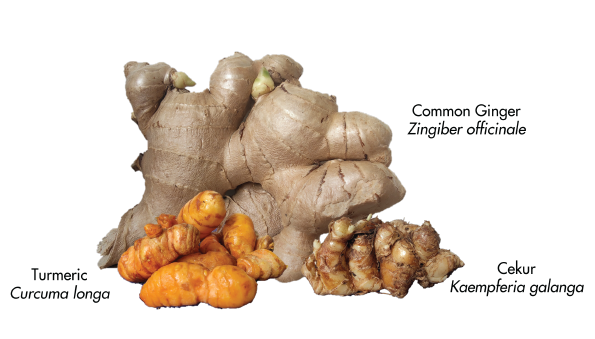
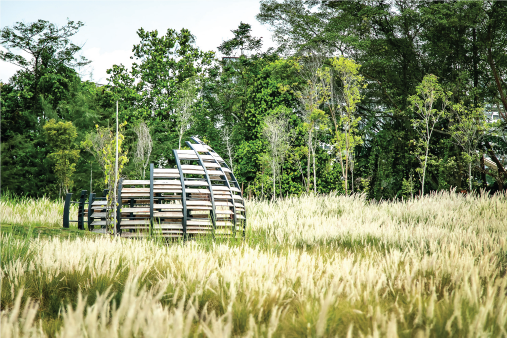
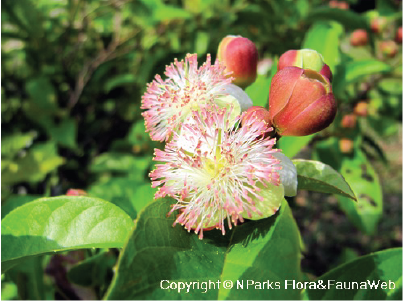
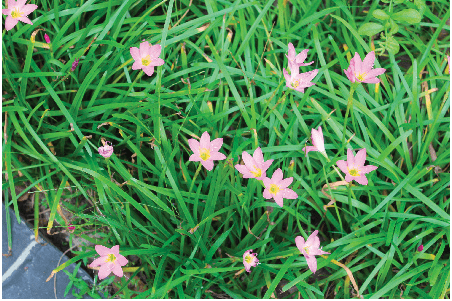
Have views or comments on this article? Let us know via this form. If you would like to give us feedback on any other areas relating to our parks and gardens, please submit via https://www.nparks.gov.sg/feedback